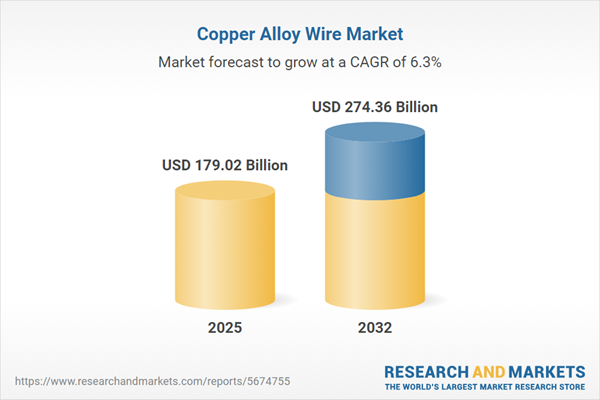Speak directly to the analyst to clarify any post sales queries you may have.
The copper alloy wire market is experiencing evolving demand as senior executives seek new avenues for performance, resilience, and sustainability. Industry developments now shape strategic decisions in sectors where conductivity, strength, and material adaptability intersect with regulatory and environmental imperatives.
Market Snapshot: Copper Alloy Wire Market Growth and Outlook
The Copper Alloy Wire Market grew from USD 168.40 billion in 2024 to USD 179.02 billion in 2025. It is expected to continue growing at a CAGR of 6.29%, reaching USD 274.36 billion by 2032. Strong expansion is fueled by innovation in electrical, automotive, and communications sectors as global industries invest in new infrastructure, progressive electrification, and advanced technology platforms.
Scope & Segmentation
- Material Types: Beryllium copper, brass, copper nickel, phosphor bronze
- End Use Industries: Aerospace, automotive, construction, electrical electronics, marine, medical, telecommunications
- Product Forms: Bare wire, nickel plated wire, silver plated wire, tinned wire
- Wire Diameters: Fine, standard, thick
- Manufacturing Processes: Annealing, cold drawing, hot drawing
- Regions: Americas (United States, Canada, Mexico, Brazil, Argentina, Chile, Colombia, Peru), Europe, Middle East & Africa (United Kingdom, Germany, France, Russia, Italy, Spain, Netherlands, Sweden, Poland, Switzerland, United Arab Emirates, Saudi Arabia, Qatar, Turkey, Israel, South Africa, Nigeria, Egypt, Kenya), Asia-Pacific (China, India, Japan, Australia, South Korea, Indonesia, Thailand, Malaysia, Singapore, Taiwan)
- Leading Companies: Wieland-Werke Aktiengesellschaft, Aurubis AG, KME Group S.p.A., Luvata Ltd, Nexans S.A., Sumitomo Electric Industries, Ltd., Hitachi Metals, Ltd., Sandvik AB, Revere Copper Products, Inc., Elmelin Industries, Inc.
Copper Alloy Wire Market: Key Takeaways for Executives
- Strategic shifts in supply chains and technology adoption are transforming competitive dynamics, enabling manufacturers to meet advanced performance benchmarks while navigating raw material volatility.
- Regulatory evolution, particularly in emissions and sourcing standards, necessitates investments in cleaner production technologies and closed-loop recycling to sustain long-term market access.
- Segment-specific demand—such as miniaturized electronics, electric vehicles, or infrastructure upgrades—drives innovation in alloy formulation and process capability.
- Regional differentiation remains pronounced: the Americas emphasize local production and resilience; EMEA balances environmental goals with industrial expansion; and Asia-Pacific sustains high-volume, cost-competitive growth driven by vertical integration and R&D.
- Leading corporations strengthen value propositions by leveraging digital platforms, predictive maintenance analytics, and responsive pricing models to deepen engagement across the supply chain.
Tariff Impact on Global Trade in Copper Alloy Wire
The 2025 revision of United States tariff schedules introduced new import duties on selected copper alloy wires, prompting both domestic and global manufacturers to diversify sourcing and reassess procurement strategies. Efforts include shifting orders to alternative regions and adjusting supply agreements to maintain margin stability in response to higher landed costs. Stakeholders also mitigate supply chain disruptions with nearshoring and enhanced logistics solutions, fostering greater supply resilience in the evolving policy environment.
Methodology & Data Sources
This report draws upon qualitative interviews with material scientists, supply chain executives, and end users, along with secondary research from industry literature and technical patents. Quantitative analysis rests on proprietary shipment data, customs and production records, with a triangulation method to validate conclusions. Scenario modeling involved internal multi-disciplinary teams for robust, actionable insights.
Why This Report Matters
- Delivers detailed analysis to support strategic investments, risk assessment, and market entry decisions for senior leadership.
- Enables cross-functional teams to tailor operational strategies according to evolving technology, regulatory, and regional market trends.
- Equips decision-makers with forward-looking perspectives, benchmarked to best-in-class competitor activity and emerging procurement models.
Conclusion
The copper alloy wire market is defined by innovation, adaptability, and regulatory responsiveness. Executives who act on these insights can foster operational resilience and secure a leadership position as industry paradigms continue to shift.
Additional Product Information:
- Purchase of this report includes 1 year online access with quarterly updates.
- This report can be updated on request. Please contact our Customer Experience team using the Ask a Question widget on our website.
Table of Contents
3. Executive Summary
4. Market Overview
7. Cumulative Impact of Artificial Intelligence 2025
Companies Mentioned
The companies profiled in this Copper Alloy Wire market report include:- Wieland-Werke Aktiengesellschaft
- Aurubis AG
- KME Group S.p.A.
- Luvata Ltd
- Nexans S.A.
- Sumitomo Electric Industries, Ltd.
- Hitachi Metals, Ltd.
- Sandvik AB
- Revere Copper Products, Inc.
- Elmelin Industries, Inc.
Table Information
| Report Attribute | Details |
|---|---|
| No. of Pages | 180 |
| Published | October 2025 |
| Forecast Period | 2025 - 2032 |
| Estimated Market Value ( USD | $ 179.02 Billion |
| Forecasted Market Value ( USD | $ 274.36 Billion |
| Compound Annual Growth Rate | 6.2% |
| Regions Covered | Global |
| No. of Companies Mentioned | 11 |









